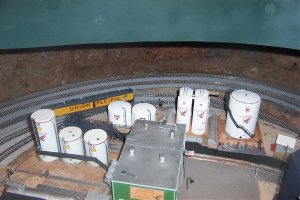This type of thing may have been discussed before, but I can not find it on the Search so I thought I would see I anyone has any thoughts.
I have several code 83 Walthers #7 curved turnouts on the layout I am working on. They seem to be prone to derailments, but I have generally been able to work out the problem..until now.
It is layed on flat plywood, attached with adhesive (no pinching nails), seems to be in gauge, has no ballast above the ties, appears to be smooth, etc.. I tested it initially and everything was fine, but now that I have structures in the way it decides to derail all locomotives under power (only when under power) when against the points.
Cars will roll through smoothly without problems either direction and locos will "slide" through by hand without power against the points, and will go through uneventfully under power with the points.
I checked the track and loco wheel gauge and they all seem fine. I have run everything from 4-axle switchers to my DD40X, in fact, the DX40 handles it better that the switcher. The front axle on the front truck always jumps to the outside of the turn between the points and the frog and then comes to a stop before the flangeways as if it has encountered an obstacle. Speed does not seem to be a factor. On the DD40X, the wheels still spin under power, but it acts as if it is bottomed out and lifted off the track. I can find nothing physical that would cause this.
Oh, yes, this is only a problem on the outside (larger-28") curve, the smaller inside curve is fine in both directions with all cars and locos. I am using code 83 flex track soldered to the turnout into and out of this turnout. I live in Colorado (dry) and doubt that humidity is the problem.
After many hours of trying everything I can think of, this one really has me puzzled. Any ideas? Gary
I have several code 83 Walthers #7 curved turnouts on the layout I am working on. They seem to be prone to derailments, but I have generally been able to work out the problem..until now.
It is layed on flat plywood, attached with adhesive (no pinching nails), seems to be in gauge, has no ballast above the ties, appears to be smooth, etc.. I tested it initially and everything was fine, but now that I have structures in the way it decides to derail all locomotives under power (only when under power) when against the points.
Cars will roll through smoothly without problems either direction and locos will "slide" through by hand without power against the points, and will go through uneventfully under power with the points.
I checked the track and loco wheel gauge and they all seem fine. I have run everything from 4-axle switchers to my DD40X, in fact, the DX40 handles it better that the switcher. The front axle on the front truck always jumps to the outside of the turn between the points and the frog and then comes to a stop before the flangeways as if it has encountered an obstacle. Speed does not seem to be a factor. On the DD40X, the wheels still spin under power, but it acts as if it is bottomed out and lifted off the track. I can find nothing physical that would cause this.
Oh, yes, this is only a problem on the outside (larger-28") curve, the smaller inside curve is fine in both directions with all cars and locos. I am using code 83 flex track soldered to the turnout into and out of this turnout. I live in Colorado (dry) and doubt that humidity is the problem.
After many hours of trying everything I can think of, this one really has me puzzled. Any ideas? Gary



